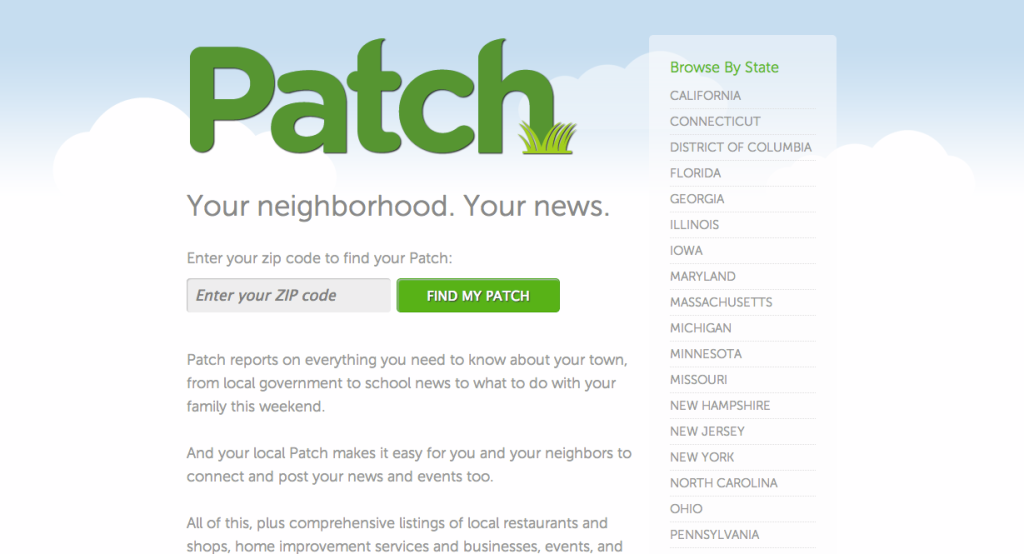

Not final closure after all for AOL’s struggling hyperlocal effort Patch, but a segue into a new life where AOL is no longer the sole owner. Today the company is spinning it off into a joint venture with technology holding company Hale Global, with AOL retaining a minority stake.
The news was sent out to AOL employees (TechCrunch is owned by AOL) in an internal memo from CEO Tim Armstrong, who described the move in classic startup terminology, “pivot.” The memo is below.
If you are asking yourself who Hale Global is, it’s not exactly a player in the consumer tech world, but it has bought and reorganised at least two other companies. In 2009, it took on a location-based services division of Autodesk called LocationLogic, subsequently selling it to Telecommuniations Systems. More recently, it’s been focused on a company called QL2 that provides software that tracks and analyses real-time pricing data on the web.
These are perhaps less pertinent facts, though, than those around Hale’s managing director, Bobby Figueroa. Before joining Hale, Figueroa held roles as VP of Product Development at Yahoo for advertising products, Head of Product Marketing for Google’s advertising products, and at Microsoft. At Patch, he can have a crack at using some of that earlier experience to turn the operation around.
Patch, which AOL acquired in 2009, has been long on aspirations but very short on financial returns over the course of its life. The idea was that AOL would use the platform to develop a chain of hyperlocal news sites, which would then help it tap into local advertising (and national advertising aiming for local audiences) alongside that content. But it was never profitable, and is estimated to have cost AOL between $200 million and $300 million to run.
Last year, after winning a proxy battle in 2012 that was partly tied to the financial problems with Patch, Armstrong made a commitment to turn Patch around. While there may have been efforts to improve the content, what we tended to hear about more were cost cutting efforts to right-size it: drastic layoffs of 40% of staff, closing and consolidating some of the local blogs, and with one particularly bad dismissal that didn’t help morale or public perception (the firing of creative director Abel Lenz was made in front of other employees, but of course, it leaked).
Despite whatever downsizing may have taken place, Patch is still large — some 900 local sites, according to the official release AOL sent out — possibly too unwieldy to steer into better waters as it is today.
But on top of that, it’s seeing decent traffic of 16 million people monthly according to figures from comScore. So now, the plan going forward will be to focus on a few changes to convert some of that traffic into revenues: new technology for community participation; more mobile-first and social experiences; better advertising tools; and more geo-targeting for ad products, according to AOL’s announcement.
Seems like a very logical set of goals, so I’m not quite sure why AOL didn’t try to focus on them itself earlier — or why, if they did, Hale is likely to execute on them better than AOL has.
In any case, AOL seems to be in the midst of some early spring cleaning. Just yesterday it finalised the sale of two music properties, Winamp and Shoutcast, to Radionomy for a price believed to be between $5 million and $10 million.
The Patch/Hale transaction is expected to close in Q1 of this year, and financial terms have not been disclosed.
AOLers,
AOL has a strong track record of improving, pivoting, and partnering – that’s what successful companies and start-ups do. AOL’s return to growth has been built by making smart investments and by calibrating our investments while moving through opportunities.We pivoted our ads business to programmatic, we pivoted our content business to powerful brands, and we pivoted our video production to becoming a video platform.
Today we are pivoting another area of our business: local. The local digital space will reach $152B by 2017, driven by a $21B growth in local digital revenue over the next three years and we have invested in local with Patch. The goal for Patch has always been simple – to be a local platform for information and commerce in towns and to serve communities in a meaningful and human way.
After extensive discussions over the last several months with many companies interested in the local media business and local platform business, today we are announcing a joint venture partnership with Hale Global. Hale Global is a private company that has a successful track record of investing and growing technology assets, and we believe they are very well positioned to nurture and grow Patch. Hale has made investments in local commerce and platforms, and they have a strong team of leaders and technical expertise. Hale’s CEO, Charlie Hale, is a strong believer in the power of local, local platforms, and local storytelling. Bud Rosenthal and Charlie Hale will be detailing Patch’s go-forward plan and next steps with the Patch team today.
AOL has delivered on our commitment to our investors and put Patch in a position to be successful. We are retaining a meaningful minority interest in the joint venture, and we stand to benefit from Patch’s pivot to platform excellence.
While Patch pivots, it is important to remember that it serves millions of consumers throughout hundreds of towns in America and partners with some of the largest and smallest businesses that serve those communities. Hale will help Patch improve, and we will be partners with Hale in the next phase of the journey – TA
More to come.


0 Responses
Stay in touch with the conversation, subscribe to the RSS feed for comments on this post.